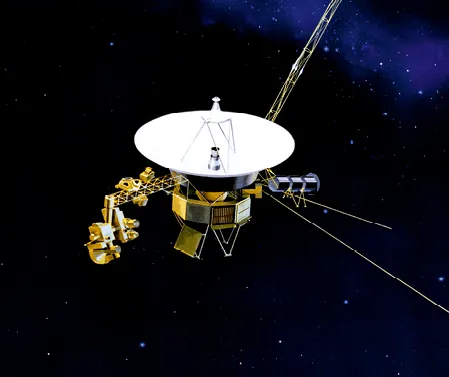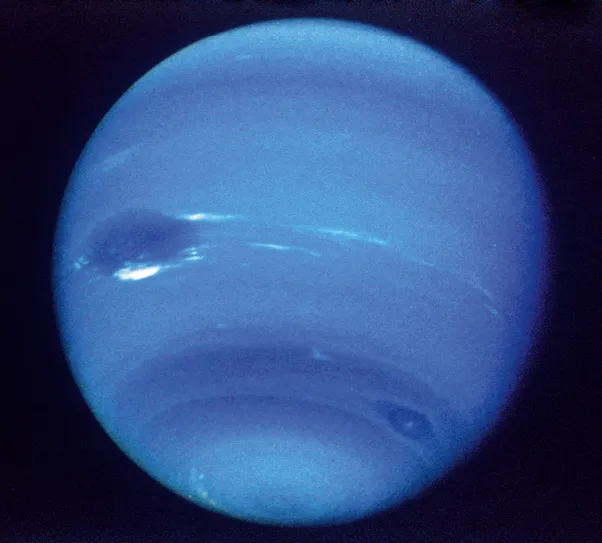Chapitre 13
Exercice corrigé
Période de Néréide
Ressource affichée de l'autre côté.
Faites défiler pour voir la suite.
Faites défiler pour voir la suite.
Énoncé
Compétence(s)
REA : Utiliser un modèle
APP : Extraire l'information utile
APP : Extraire l'information utile


Voyager 2 (NASA) est l'unique sonde à avoir survolé la planète Neptune en 1989. Cette dernière possède au moins 14 satellites, dont Triton, Néréide et Larissa. Triton orbite de manière circulaire autour de Neptune à une distance r_{\mathrm{Tri}}=3{,}547 \times 10^{5} km. Néréide possède une trajectoire très elliptique de demi-grand axe a_{\mathrm{Ner}}=5\ 513 \times 10^{3} km.
1. Montrer que le mouvement de Triton est uniforme tel que l'expression de la vitesse orbitale est \nobreakspace{v_{\mathrm{Tri}}=\sqrt{\frac{G \cdot M_{\mathrm{Nep}}}{r_{\mathrm{Tri}}}}} et calculer la valeur de la vitesse orbitale de Triton.
2. Énoncer la 3e loi de Kepler pour les satellites de Neptune. Calculer la valeur de la période de révolution de Néréide.
1. Montrer que le mouvement de Triton est uniforme tel que l'expression de la vitesse orbitale est \nobreakspace{v_{\mathrm{Tri}}=\sqrt{\frac{G \cdot M_{\mathrm{Nep}}}{r_{\mathrm{Tri}}}}} et calculer la valeur de la vitesse orbitale de Triton.
2. Énoncer la 3e loi de Kepler pour les satellites de Neptune. Calculer la valeur de la période de révolution de Néréide.
Ressource affichée de l'autre côté.
Faites défiler pour voir la suite.
Faites défiler pour voir la suite.
Données
- Constante de gravitation universelle : G=6{,}67 \times 10^{-11} m3·kg‑1·s-2
- Masse de Neptune : M_{\mathrm{Nep}}=1{,}025 \times 10^{26} kg
- Masse de Triton : M_{\mathrm{Tri}}=2,15 \times 10^{22} kg
- Masse de Néréide : M_{\mathrm{Ner}}=3{,}1 \times 10^{19} kg
- Période de révolution de Triton : T_{\mathrm{Tri}}=5 j 21 h
Ressource affichée de l'autre côté.
Faites défiler pour voir la suite.
Faites défiler pour voir la suite.
Protocole de réponse
1. Effectuer un bilan des forces appliquées au système.
Appliquer la 2e loi de Newton.
Exprimer les coordonnées \vec{a} dans le repère de Frenet.
Déterminer la valeur de la vitesse v à l'aide de la composante normale de \vec{a} .
Veiller à utiliser les unités du système international et à donner le nombre de chiffres significatifs adapté.
2. Rappeler que T^2 est proportionnel à r^3.
Effectuer le calcul avec les unités du système international.
Appliquer la 2e loi de Newton.
Exprimer les coordonnées \vec{a} dans le repère de Frenet.
Déterminer la valeur de la vitesse v à l'aide de la composante normale de \vec{a} .
Veiller à utiliser les unités du système international et à donner le nombre de chiffres significatifs adapté.
2. Rappeler que T^2 est proportionnel à r^3.
Effectuer le calcul avec les unités du système international.
Ressource affichée de l'autre côté.
Faites défiler pour voir la suite.
Faites défiler pour voir la suite.
Solution rédigée
1. En supposant que seule l'attraction gravitationnelle de Neptune s'exerce sur Triton, l'application de la 2e loi de Newton donne
:
AN : v_{\mathrm{Tri}}=\sqrt{\frac{6{,}67 \times 10^{-11} \times 1,025 \times 10^{26}}{3{,}547 \times 10^{8}}}=4{,}39 \times 10^{3} m⋅s-1
2. La 3e loi de Kepler stipule que T^2 est proportionnel à r^3 :
T_{\mathrm{Ner}}=T_{\mathrm{Tri}} \cdot\left(\frac{a_{\mathrm{Ner}}}{r_{\mathrm{Tri}}}\right)^{\normalsize\tfrac{3}{2}}
AN : T_{\mathrm{Ner}}=(5 \times 24+21) \times 3\ 600 \times\left(\frac{5\ 513 \times 10^{3}}{3{,}547 \times 10^{5}}\right)^{\normalsize\tfrac{3}{2}}
T_{\mathrm{Ner}}=3{,}11 \times 10^{7} \mathrm{s}=360 j
M_{\mathrm{Tri}} \cdot \vec{a}=G \cdot \frac{M_{\mathrm{Tri}} \cdot M_{\mathrm{Nep}}}{r_{\mathrm{Tri}}\:^{2}} \cdot \vec{N}
On considère le mouvement circulaire uniforme. On a donc
:
\vec{a}\left(\begin{array}{cc}0\\\frac{v_{\mathrm{Tri}}\:^{2}}{r_{\mathrm{Tri}}}=G \cdot \frac{M_{\mathrm{Nep}}}{r_{\mathrm{Tri}}\:^{2}}\end{array}\right)_{(\mathrm{G}, \vec{T}, \vec{N})}
Soit
:
v_{\mathrm{Tri}}=\sqrt{\dfrac{G \cdot M_{\mathrm{Nep}}}{r_{\mathrm{Tri}}}}AN : v_{\mathrm{Tri}}=\sqrt{\frac{6{,}67 \times 10^{-11} \times 1,025 \times 10^{26}}{3{,}547 \times 10^{8}}}=4{,}39 \times 10^{3} m⋅s-1
2. La 3e loi de Kepler stipule que T^2 est proportionnel à r^3 :
\dfrac{T_{\mathrm{Tri}}\:^{2}}{r_{\mathrm{Tri}}\:^{3}}=\frac{T_{\mathrm{Ner}}\:^{2}}{a_{\mathrm{Ner}}\:^3}
On en déduit
:T_{\mathrm{Ner}}=T_{\mathrm{Tri}} \cdot\left(\frac{a_{\mathrm{Ner}}}{r_{\mathrm{Tri}}}\right)^{\normalsize\tfrac{3}{2}}
AN : T_{\mathrm{Ner}}=(5 \times 24+21) \times 3\ 600 \times\left(\frac{5\ 513 \times 10^{3}}{3{,}547 \times 10^{5}}\right)^{\normalsize\tfrac{3}{2}}
T_{\mathrm{Ner}}=3{,}11 \times 10^{7} \mathrm{s}=360 j
Ressource affichée de l'autre côté.
Faites défiler pour voir la suite.
Faites défiler pour voir la suite.
Doc. Photographie de Neptune prise par Voyager 2


Ressource affichée de l'autre côté.
Faites défiler pour voir la suite.
Faites défiler pour voir la suite.
Mise en application
Découvrez l', pour travailler cette notion.
Ressource affichée de l'autre côté.
Faites défiler pour voir la suite.
Faites défiler pour voir la suite.
Découvrez Triton, le plus grand des satellites connus de Neptune, en .
Une erreur sur la page ? Une idée à proposer ?
Nos manuels sont collaboratifs, n'hésitez pas à nous en faire part.
j'ai une idée !
Oups, une coquille


